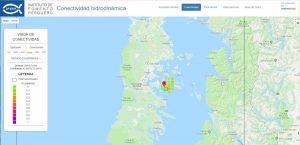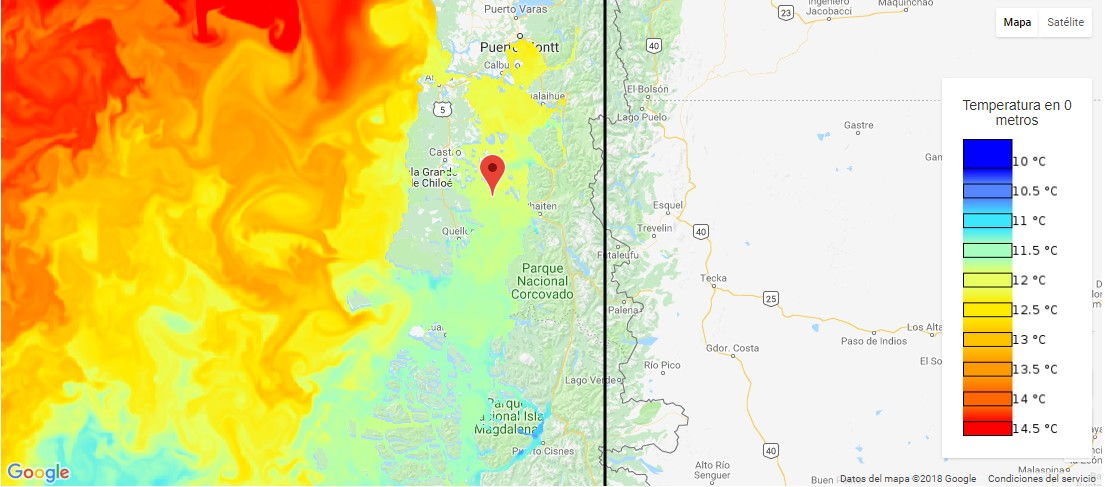CHONOS oceanographic information site launched by IFOP and Subpesca
May 15th, 2018 Information about currents, temperature and sea salinity between Los Lagos and Aysén regions. Connectivity statistics among water plots through climate scenarios. It’s free and public you can find it at https://www.ifop.cl/chonos/
Information about currents, temperature and sea salinity between Los Lagos and Aysén regions. Connectivity statistics among water plots through climate scenarios. It’s free and public you can find it at https://www.ifop.cl/chonos/
Fisheries Development Institute (IFOP) jointly with Undersecretary of Fisheries and Aquaculture launched a new oceanographic information site called CHONOS, “whose name has been coined because seas that lie between Chiloé island and Golfo de Penas which was inhabited by Chonos, natives that were considered great navigators, who were mainly dedicated to fishing and had a great knowledge of their marine environment “said Elías Pinilla, IFOP researcher and part of the project.
Recovering that spirit, IFOP has implemented a web system that allows oceanographic forecasts, through the following applications:
- MOSA-ROMS: delivers synoptic projections to 72 hours of currents, temperature and sea salinity between Los Lagos and Aysén regions.
- Connectivity – CLIC: Connectivity statistics between water plots according to different climate scenarios. CLIC will make possible to evaluate territorial ordering of salmon farming performance from a sanitary point of view regarding disease transmission risk among concessions and macrozones groups.
- Parti-MOSA: It is a tool that allows to simulate inanimate particles dispersion, using MOSA-ROMS results.
Eduardo Riquelme, Fisheries and Aquaculture Undersecretariat, explained ” Chonos portal provides valuable, timely and reliable oceanographic information about Chilean Patagonia marine environment. These data, related to variables as diverse as currents, temperature and waters salinity, will allow, for example, to better understand the environment, to make better decisions to safeguard sustainability or, even, to manage environmental or sanitary contingencies more efficiently. ”
Leonardo Guzmán, head of IFOP aquaculture division added “represents a milestone in bringing knowledge of Chilean Patagonia marine environment to general public”, also highlighting its usefulness as ” information source for decision-making in all human activity management depends on, or affects, environmental conditions where they are located “.
Fisheries Development Institute has carried out studies since 2011 in Chilean Patagonia waters. They are carried out to understand physical, chemical and biological environmental processes that take place in southern Chile seas, within the framework of an ecosystemic approach, and maintaining in its design development numerical modeling objective. The latter is based on numerical modeling provided capacity to expand and improve environmental system knowledge based on specific measurements that the Institute carries out in its oceanographic campaigns. Thanks to Chonos implemented applications and tools , this knowledge and understanding of the environment is facilitated, which will allow improving territory management and planning towards sustainable productive activities development that take place in Chile’s southern seas, as well as , environmental or sanitary contingencies management.
Cristian Ruiz, IFOP researcher, referred to the importance of the site mentioning that this “allows us to have the capacity to know future ocean states in an high value for the country area , allowing us to anticipate complex environmental scenarios for productive activities, it allows generating adequate territorial planning policies and, no less relevant, increases knowledge of the area in which CHONOS operates. Therefore, having an oceanographic forecast model is a key first step, but it must be accompanied by a Patagonia observation system that involves all the actors present, a task still pending”.
Pablo Reche, IFOP researcher spoke about Connectivity – CLIC ” assessment of salmon farming industry current zoning is the first step before adopting other measures in case current order shows inefficiencies in preventing infectious outbreaks among culture centers spread”.
Reche also points out that future of connectivity research line objectives include “a possible improvement of health areas management in case current studies deliver results in that line, along with connectivity coupling to forecast models , which will make available a very valuable tool for health emergencies”.
As for Parti-MOSA, it is a decoupled module, which works with MOSA-ROMS results, to simulate particle trajectories forecasts with a 72-hour range. These results identify impact or influence areas against different scenarios and applications, such as pollutant discharges or salvage and rescue, among others. Pablo Reche points out that ” particle dispersion coupling models to forecast models is of great importance to begin the development of connectivity tools for the containment of health emergencies”.
